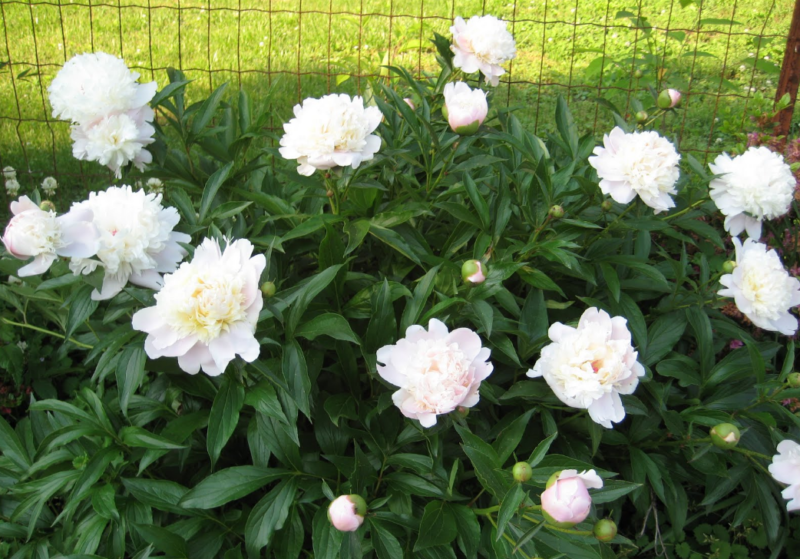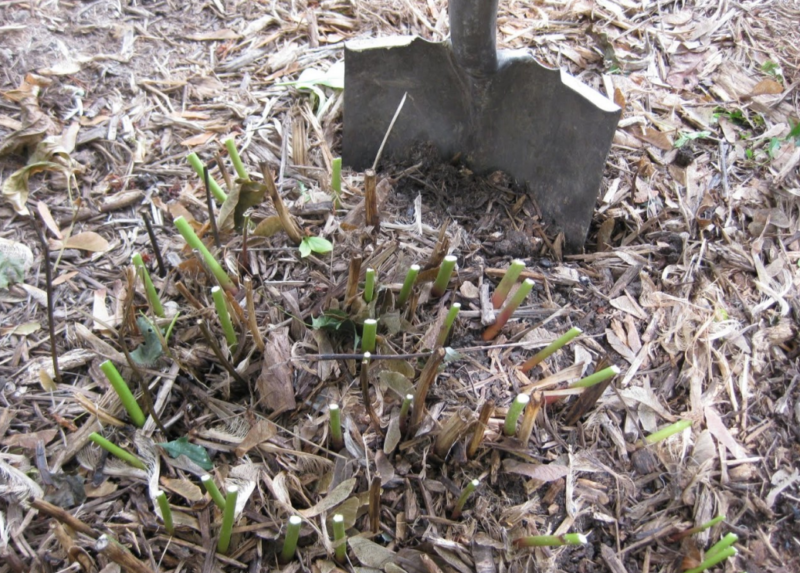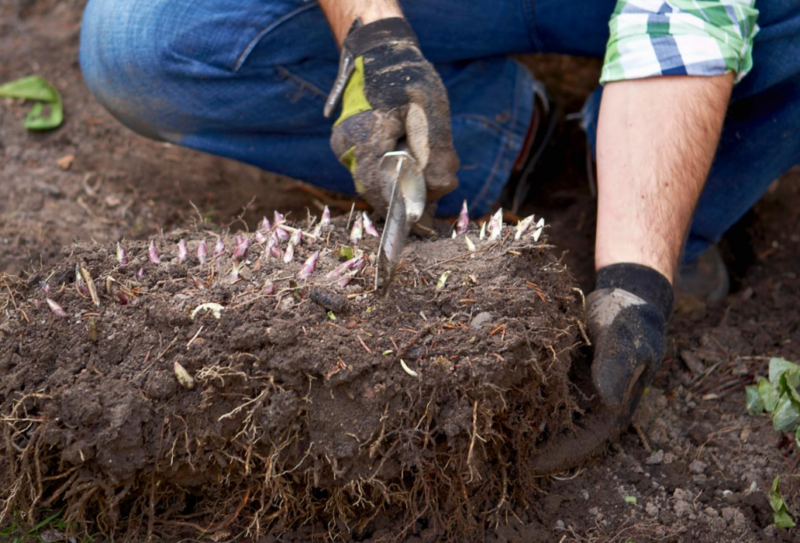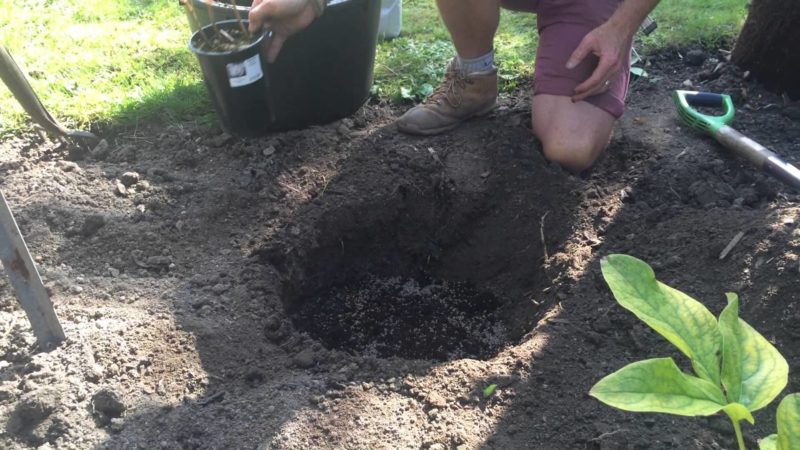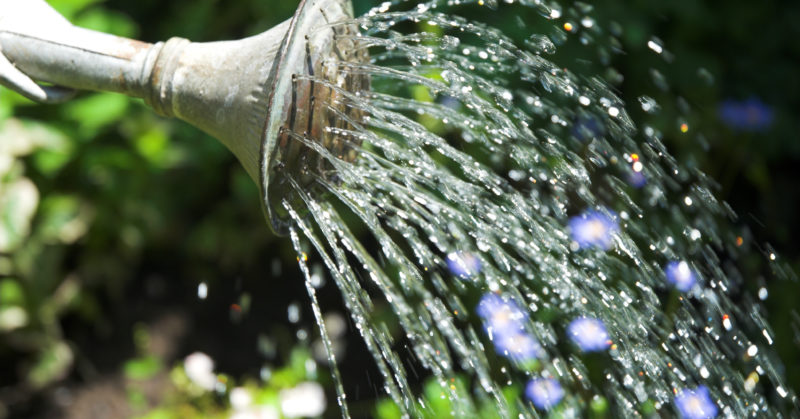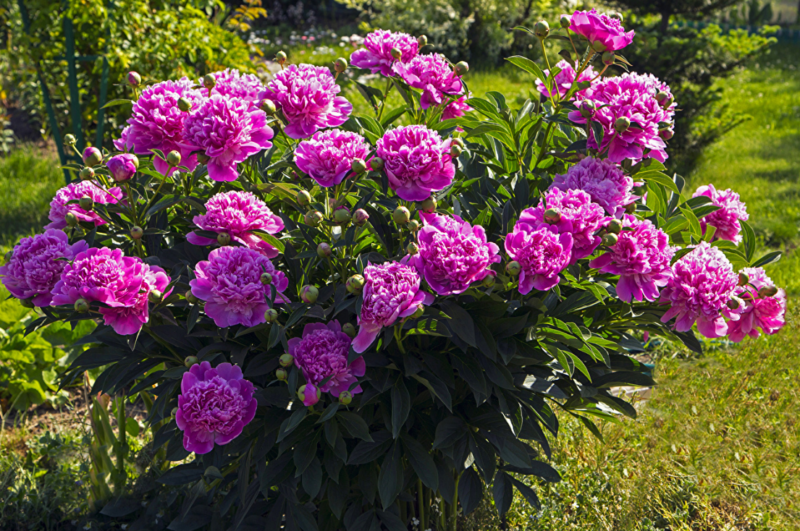Gardeners know that in one place peony bushes can exist for up to 10 years. Peony transplantation may be required if you want to propagate the plant or you decide to make a “permutation” on your site. Peonies are unpretentious plants, they can easily move from place to place, but still there are a lot of nuances in the transplant. If done correctly, the flowers will delight you with their beauty and splendor.
Material Content:
Peony transplant timing
The best time for plant transfer is autumn.
Division of the root and transplantation of peonies to another place is recommended in September, since it is in this month that the rains begin, and the rooting will be successful.
If you live in the southern part of the country, then a transplant can be arranged in October, but residents of harsh regions cannot do this. The fact is that from the second month of autumn, frosts can already begin, which is dangerous for a fragile plant. Peonies need at least 2 weeks to root.
In the springtime, it is also possible to transplant, but still not recommended: spring weather is changeable, and late frosts can suddenly strike.
When there is no choice, you need to transfer the bushes in the spring, choose a period from mid-April to mid-May. In the last days of spring and summer, peonies cannot be transplanted, because during this period of time the plant has no suction roots, and the flower simply does not take root.
The main advantages of the autumn transplant:
- Due to the decline in heat and the presence of a large amount of rain, the sprout will definitely take root.
- You will see the first flowering already next summer.
During the spring transplant, peonies get sick a lot: a flower stalk cannot form in them, the plant spends all its strength on rooting.
What conditions should be
The first thing to consider is the state of the plant itself. Weakened and diseased bushes are best left untouched. Try to reanimate peonies and transplant them when they get stronger.
If everything is fine with the bushes, then you can safely get to work.
But not every day is suitable for this matter. The conditions should be as follows:
- Warm weather, but not hot.
- Adequate amount of moisture.
- The absence of sudden changes in temperature.
All the prescribed conditions coincide precisely with September, in the spring it is very difficult to choose a period for work.
Not only the weather depends on the possibility of a transplant, but also on the place chosen for this. In advance, you need to prepare the soil in the optimal area for peony growth.
Choose a place well lit by the sun, far from buildings, bushes and trees. Peonies love space, but the site should be calm. The ideal place for planting is at the southern wall of the house, from which the distance to the beds is at least 2 meters.
Peonies can tolerate shade, but it affects the quality of vegetation.
In shaded areas, the flowers will be small and faded, and the bush is weak.
Planting peonies like loose soil, which receives good air and water.
The ideal soil composition will be the following (all in equal proportions):
- humus (necessarily rotted);
- peat;
- turf land;
- coarse sand.
When the soil on the site is too poor, it is recommended that iron sulfate be added to it.
Another condition is the introduction into each pion planting pit of a nutritious mixture, which consists of wood ash, bone meal and superphosphate. The first two components are taken in equal parts, and the last is required two times less.
The correct division of the root
Rhizomes of peonies in depth can go up to 90 cm! Therefore, it is especially important to do as little harm as possible.
Use forks and crowbar to work, perform the procedure as follows:
- Dig a bush with a pitchfork at a distance of 25-30 cm from the stem.
- Stick the scrap, loosen the earthen lump.
- Using a pitchfork, remove the root with the ground to the surface.
Prepare warm water, rinse the rhizomes, cut off rotten and dead sections with a pruner. Next, the root should be placed in a warm, weak solution of potassium permanganate for half an hour.
With a garden knife, start dividing the root so that at least 2 roots and at least 4 living buds remain on each sprout. The places of cuts and areas of the root damaged when digging out should be treated with coal powder. To obtain one, you can use activated, coal or charcoal.
If the plans do not divide the bush, then rhizomes do not need to be washed. Just dig a bush and, along with lumps of old soil, transfer to a new place.
Flower transplant instruction
Peonies do not like transplantation, like all other perennials. But if there is no choice, then you can relocate the bush with minimal losses. The main thing is to comply with the terms of transplantation and the rules.
In order for the plant to take root, not hurt, you need to follow the following instructions:
- In the selected area, a week before transplantation, you need to prepare the recesses. Dig holes with a distance of 1 m from each other, according to the number of bushes. The depth and width of the holes is from 50 to 60 cm.
- In each hole, put a layer of 20 cm of broken brick, you can take gravel. Next, put a layer of 20 cm from the nutrient mixture, the composition of which is described above.
- Sprinkle nutrient soil, leave holes for a week. During this time, the soil should settle, and a good depression for the roots will appear.
- Place the roots in a hole, sprinkle with soil so that the buds on the stem remain on the surface. Tamp the ground, mulch with hay, sawdust or manure.
- Step away from the stem 30 cm, and dig a trench around (it is needed to divert excess water from the stem).
Transplanting peonies in the fall to another place involves watering. After the roots are sprinkled with earth, under each bush should be added 5 liters of water.
If peonies are transplanted in the spring, then you can not water the bushes for the first 3 days.
Moisture is still sufficient from thawed snow, and it can hit frosts, which will adversely affect the rooting of plants in frozen soil.
Caring for a bush in a new place
After the planting, you need to trim the old stem, if you did not do this when dividing the roots.
Further care is as follows:
- Water once every 4 days. Under each bush you need to make 10 liters of water. In the spring, watering is carried out in this order until the growth of new shoots begins. If transplanted in the fall, then watering is carried out until October. But there is absolutely no need to water if there is enough rain.
- So that new buds begin to grow faster, and the plant is easier to take root, make a one-time watering with fertilizer. For 10 liters of water, dilute 1 tbsp. l superphosphate and potassium sulfate.
In regions with harsh winters, plantings need to be sheltered for the winter. Lay out a layer of 15 cm on the soil over the bushes of spruce branches, sawdust, peat or compost.
Features for different varieties
Varieties of peonies are diverse. There are grassy species of this plant, and tree-like, care for which does not differ.
But there are some differences according to the rules of transplantation:
- It is recommended to transplant tree peonies only in autumn, after pruning old shoots and harvesting flowers.
- Grassy varieties are transplanted necessarily once every 10 years (possible more often, but with an interval of at least 5 years). Treelike trees move worse, therefore it is better not to touch them at all until it is needed (or replant no more than once every 10-15 years).
Peony is a beautiful flowering plant, it is popular among gardeners of all countries and all climatic zones. The lush bush is decorated with dozens of large flowers that delight the eyes of the owner and ordinary passers-by. But the peony will not bloom, it may even die if you do not follow the rules of transplantation and further care. Our article is intended for experienced and beginner gardeners. Guided by the tips and recommendations posted in the publication, you will succeed, and the plant will quickly take root in a new place!


